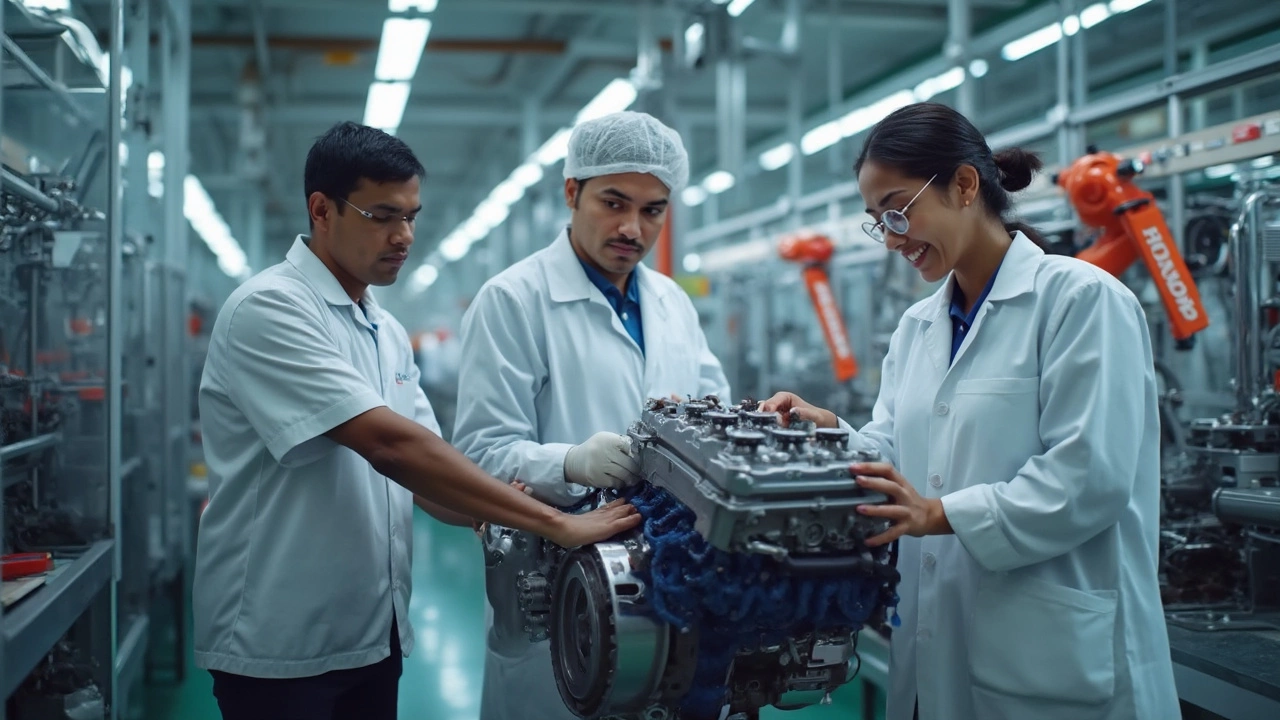Picture this: you’re strolling through a bustling Indian factory floor where the hum of machines is as constant as the scent of engine oil. This isn’t just any industrial facility—this is where Honda engines come to life in India. Some of the world’s most trusted engines power everything from motorcycles and scooters to generators and water pumps across the country. But have you ever stopped to wonder – who actually makes these Honda engines in India? Let’s pull back the curtain and see what’s really happening behind the scenes.
Honda’s Manufacturing Footprint in India
Now, Honda isn’t just a big name in India—it’s practically an institution. Since the early 1980s, Honda has invested heavily in setting up manufacturing hubs tailored specifically for Indian needs. The two main forces here are Honda Motorcycle & Scooter India (HMSI) and Honda Cars India Ltd. But when it comes down to actual engine production, things get interesting.
Honda’s journey in India began with joint ventures like Hero Honda back in 1984. They used a blend of Japanese engineering and local manufacturing to mass-produce two-wheeler engines. Fast-forward to today, and Honda stands on its own with fully-owned plants. The largest, located in Manesar (Haryana), Narsapura (Karnataka), Tapukara (Rajasthan), and Vithalapur (Gujarat), are buzzing hubs where millions of engines are built every year. These units don’t just assemble bikes—they’re real, soup-to-nuts engine factories, complete with foundries and machine shops that produce everything from crankcases to pistons on Indian soil.
What’s wild is the scale. Say, in 2022, HMSI was rolling out over 6 million two-wheeler engines annually. That’s a mind-boggling number—just imagine the sheer number of bikes lining up on roads, each with an engine crafted right there in India. The focus isn’t only on two-wheelers, either. Honda also makes small utility engines used for water pumps, generators, and agricultural equipment, especially through their Power Products division in Greater Noida. So whether you’re riding to work or irrigating a field, there’s a good chance you’re leaning on a Honda engine made nearby.
One thing most people don’t know? Honda’s Indian plants are some of the brand’s most advanced globally. They import core tech and blueprints from Japan but manufacture nearly everything with local talent and materials. These facilities even supply engines and parts to other countries—not just feeding local demand but becoming an export powerhouse.
Joint Ventures and Partnerships—A Story of Evolution
The Honda story in India can’t be told without its complex web of joint ventures and partnerships. It all started with Hero Honda, a name every bike lover from the 80s and 90s remembers fondly. The Hero Honda joint venture brought together Hero’s market smarts and Honda’s engine wizardry, churning out classics like the CD100—a bike built to last for generations, often living longer than the family dog (no offense to Max, my own pup back home).
But as the gears of business shifted, Honda charted its own path, stepping out solo as Honda Motorcycle & Scooter India (HMSI) in 1999. This was a big deal. With a full focus on Indian manufacturing, Honda transformed its partnerships into direct investments, pouring money into ground-up plants that didn’t just assemble engines—they engineered and built them from scratch right there in India.
Don’t think partnerships disappeared, though. Honda still works with hundreds of Indian suppliers, sharing designs, quality protocols, and training. The company routinely invites partners to workshops to learn about lean manufacturing, automation, and robotics—making sure every bolt, piston, and gasket made by a supplier fits Honda’s famously strict standards. Over the years, these supplier relationships have matured into a local ecosystem, driving innovation and reliability. There’s also crossover with Honda’s auto division, which manufactures car engines at its Tapukara plant. It’s all interconnected, with know-how and parts moving smoothly across the wide Honda supply web.
If you're hunting for the heart of the Honda engine operation, look to these purpose-built locations:
- Manesar (Haryana): Focused on engine manufacturing for scooters and motorcycles, with impressive automation levels.
- Narsapura (Karnataka): Key powerhouse for high-volume scooter engine production, especially the beloved Activa.
- Tapukara (Rajasthan): Houses both car and two-wheeler engine lines with a strong lean towards green manufacturing.
- Greater Noida (Uttar Pradesh): Produces both power equipment and engine components for bikes and cars.

Engine Technology and Quality Standards
There’s this myth that locally-made engines somehow don’t measure up to their Japanese siblings. Let’s clear the air—Honda engines made in India aren’t cheap knock-offs, but full-blooded Honda machines built to global standards. The tech transfer here isn’t watered down. Honda’s Japanese engineers spend months training Indian teams. Every process—from CNC machining to the final dyno tests—is done on cutting-edge equipment. The focus on quality borders on obsessive.
Honda India plants roll out powertrains packed with next-gen tech. Take, for instance, the HET (Honda Eco Technology) that squeezes more mileage out of every drop of petrol without sacrificing power. This isn’t just a marketing sticker; the engines really do deliver. The legendary Honda Activa scooter’s engine, for example, leads the field in reliability. I know a delivery guy in Mumbai who’s racked up over 200,000 kilometers on his 2014 Activa, and his only complaint is a worn-out seat cover—not the engine!
Honda’s Indian plants hold every major quality and environmental certification you can name—ISO 9001 for quality management, ISO 14001 for eco-friendly operations, and OHSAS 18001 for workplace safety. Engines are tested in dust chambers, run at full throttle for hours, and even dunked in water to check for leaks. Honda relies on intricate laser-based inspection tools to catch even microscopic flaws. Is this overkill? Maybe—but that’s how you see its engines running strong for a decade plus in some of the worst conditions you can imagine, from bone-dry Rajasthan to monsoon-soaked Kerala.
And the technology is always evolving. Honda’s fueled the shift to BS-VI emission standards in India, slashing pollution and setting the tone for the rest of the market. Engineers at these plants aren’t just following directions—they’re innovating, tweaking engine calibrations for local fuel, and optimizing designs for India’s wild mix of traffic, weather, and road quality.
Honda Engine Production: Tips, Trivia, and The Road Ahead
Now, if you care about getting a long life out of your Honda engine—whether it’s for your scooter, generator, or water pump—know this: maintenance is key, but so are authentic parts. Sounds obvious, but counterfeit spares flood the Indian market. Only stick with authorized Honda service centers and genuine spares. The same suppliers who provide these parts to Honda’s plants supply them to the service network—you get the same reliability, no matter if it’s a new bike or an old generator.
Here’s a cool tip most folks never hear: serial numbers on Honda engines reveal their manufacturing plant and date. If you own a Honda two-wheeler, check the engine code. For example, numbers starting with ‘JC’ or ‘JA’ are for common scooter engines, and you can trace those codes to the factory floor in Manesar or Narsapura. Honda’s website (and most forums) let you decode these numbers, which helps if you’re buying a used bike and want to be sure you’re not getting a dodgy import or a ‘rebadged’ grey-market motor.
If you’ve ever marveled at how Honda engines start effortlessly on frosty mornings or keep running in punishing, dusty heat, that’s not by accident. Plants in India spend countless hours simulating local conditions. When my buddy in Tamil Nadu uses his Honda pump to irrigate during power cuts, it’s the same story—reliable starts, every time, year after year.
Looking ahead, Honda isn’t slowing down. Plans are afoot for hybrid and electric power units, and Indian engineers are at the heart of it. The roadmap includes engines designed for ethanol-blend fuels and lower emission targets, not just for India but for export, too. With rising investment in automation, expect even tighter manufacturing tolerances—meaning engines will run longer, burn cleaner, and cost less to own.
Honda’s engine factories in India aren’t just making products. They’re setting global benchmarks, offering tech jobs to thousands, and proving that world-class engineering doesn’t need a Tokyo address. People across India—and even in other countries—are counting on these locally-built engines every day. That's something to appreciate, whether you’re kick-starting your Honda bike or firing up a reliable generator during another monsoon blackout.
